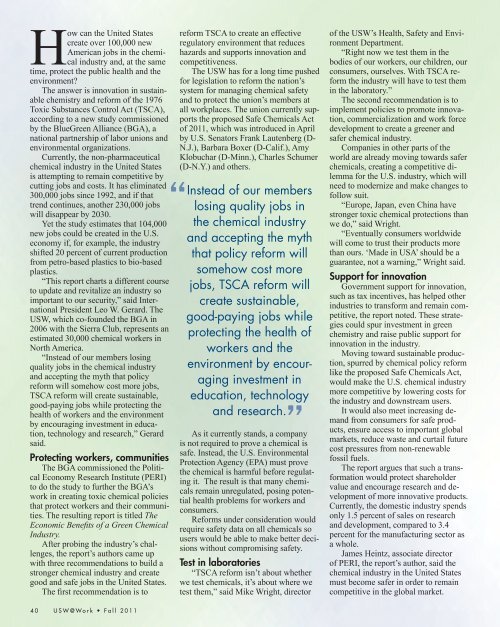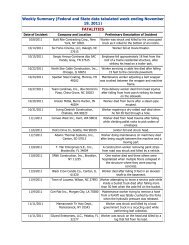National College Players Association - United Steelworkers
National College Players Association - United Steelworkers
National College Players Association - United Steelworkers
You also want an ePaper? Increase the reach of your titles
YUMPU automatically turns print PDFs into web optimized ePapers that Google loves.
How can the <strong>United</strong> Statescreate over 100,000 newAmerican jobs in the chemicalindustry and, at the sametime, protect the public health and theenvironment?The answer is innovation in sustainablechemistry and reform of the 1976Toxic Substances Control Act (TSCA),according to a new study commissionedby the BlueGreen Alliance (BGA), anational partnership of labor unions andenvironmental organizations.Currently, the non-pharmaceuticalchemical industry in the <strong>United</strong> Statesis attempting to remain competitive bycutting jobs and costs. It has eliminated300,000 jobs since 1992, and if thattrend continues, another 230,000 jobswill disappear by 2030.Yet the study estimates that 104,000new jobs could be created in the U.S.economy if, for example, the industryshifted 20 percent of current productionfrom petro-based plastics to bio-basedplastics.“This report charts a different courseto update and revitalize an industry soimportant to our security,” said InternationalPresident Leo W. Gerard. TheUSW, which co-founded the BGA in2006 with the Sierra Club, represents anestimated 30,000 chemical workers inNorth America.“Instead of our members losingquality jobs in the chemical industryand accepting the myth that policyreform will somehow cost more jobs,TSCA reform will create sustainable,good-paying jobs while protecting thehealth of workers and the environmentby encouraging investment in education,technology and research,” Gerardsaid.Protecting workers, communitiesThe BGA commissioned the PoliticalEconomy Research Institute (PERI)to do the study to further the BGA’swork in creating toxic chemical policiesthat protect workers and their communities.The resulting report is titled TheEconomic Benefits of a Green ChemicalIndustry.After probing the industry’s challenges,the report’s authors came upwith three recommendations to build astronger chemical industry and creategood and safe jobs in the <strong>United</strong> States.The first recommendation is toreform TSCA to create an effectiveregulatory environment that reduceshazards and supports innovation andcompetitiveness.The USW has for a long time pushedfor legislation to reform the nation’ssystem for managing chemical safetyand to protect the union’s members atall workplaces. The union currently supportsthe proposed Safe Chemicals Actof 2011, which was introduced in Aprilby U.S. Senators Frank Lautenberg (D-N.J.), Barbara Boxer (D-Calif.), AmyKlobuchar (D-Minn.), Charles Schumer(D-N.Y.) and others.“ Instead of our memberslosing quality jobs inthe chemical industryand accepting the myththat policy reform willsomehow cost morejobs, TSCA reform willcreate sustainable,good-paying jobs whileprotecting the health ofworkers and theenvironment by encouraginginvestment ineducation, technology”and research.As it currently stands, a companyis not required to prove a chemical issafe. Instead, the U.S. EnvironmentalProtection Agency (EPA) must provethe chemical is harmful before regulatingit. The result is that many chemicalsremain unregulated, posing potentialhealth problems for workers andconsumers.Reforms under consideration wouldrequire safety data on all chemicals sousers would be able to make better decisionswithout compromising safety.Test in laboratories“TSCA reform isn’t about whetherwe test chemicals, it’s about where wetest them,” said Mike Wright, directorof the USW’s Health, Safety and EnvironmentDepartment.“Right now we test them in thebodies of our workers, our children, ourconsumers, ourselves. With TSCA reformthe industry will have to test themin the laboratory.”The second recommendation is toimplement policies to promote innovation,commercialization and work forcedevelopment to create a greener andsafer chemical industry.Companies in other parts of theworld are already moving towards saferchemicals, creating a competitive dilemmafor the U.S. industry, which willneed to modernize and make changes tofollow suit.“Europe, Japan, even China havestronger toxic chemical protections thanwe do,” said Wright.“Eventually consumers worldwidewill come to trust their products morethan ours. ‘Made in USA’ should be aguarantee, not a warning,” Wright said.Support for innovationGovernment support for innovation,such as tax incentives, has helped otherindustries to transform and remain competitive,the report noted. These strategiescould spur investment in greenchemistry and raise public support forinnovation in the industry.Moving toward sustainable production,spurred by chemical policy reformlike the proposed Safe Chemicals Act,would make the U.S. chemical industrymore competitive by lowering costs forthe industry and downstream users.It would also meet increasing demandfrom consumers for safe products,ensure access to important globalmarkets, reduce waste and curtail futurecost pressures from non-renewablefossil fuels.The report argues that such a transformationwould protect shareholdervalue and encourage research and developmentof more innovative products.Currently, the domestic industry spendsonly 1.5 percent of sales on researchand development, compared to 3.4percent for the manufacturing sector asa whole.James Heintz, associate directorof PERI, the report’s author, said thechemical industry in the <strong>United</strong> Statesmust become safer in order to remaincompetitive in the global market.40 USW@Work • Fall 2011






